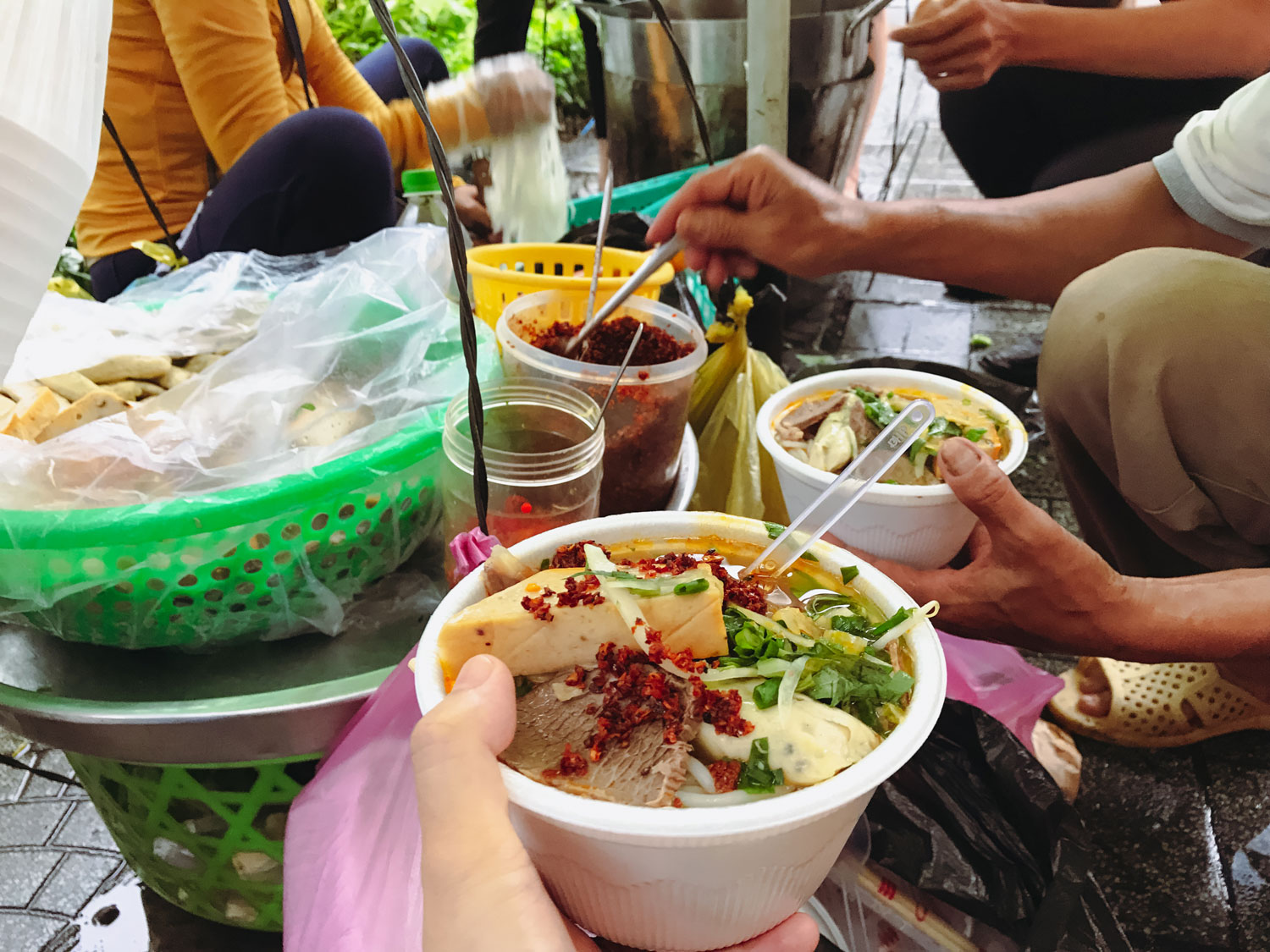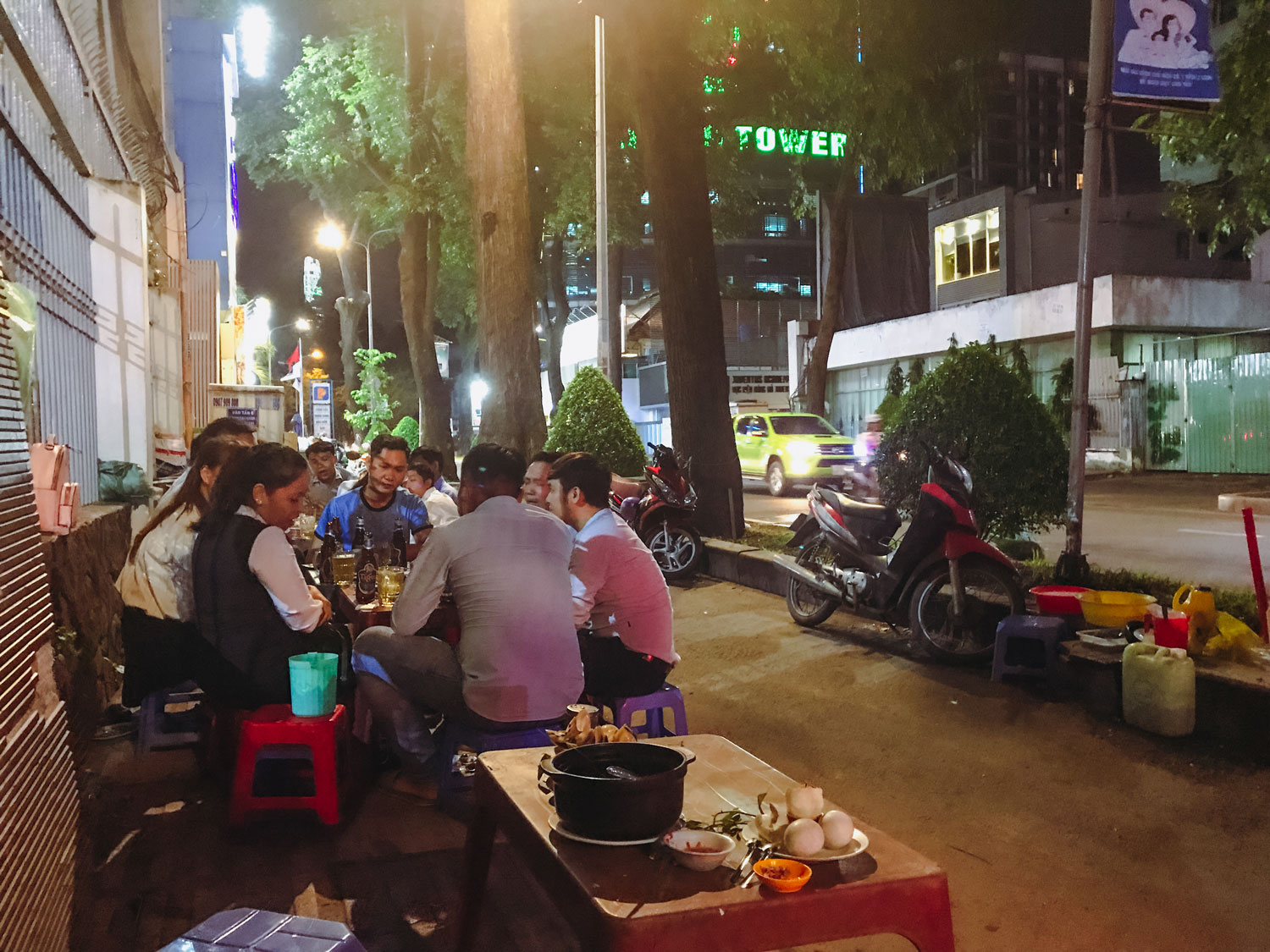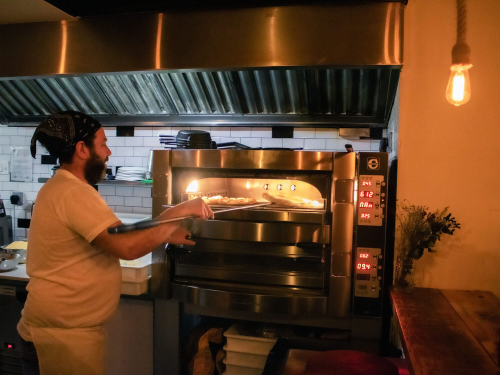
My hands were sticky from opening the last blood cockles, picking out the plump flesh with a toothpick and dipping them in lime juice flavored with salt and pepper, and chili.
I hesitated if I should order one more portion of sò huyết rang muối ớt (grilled blood cockles with salt and chili). Or perhaps go for ốc cà na hấp gừng sả (sea snails steamed with ginger and lemongrass) instead. The spicy, aromatic clear broth the snails are cooked in is like a warm hug you can’t stop sipping.
I didn’t know the names of these two dishes at the time, saved by a stained laminated menu with photos.
“Just order them both,” says my husband, slightly annoyed. He was not a fan of shellfish and was reluctantly familiar with my indecisive ways. He was only there to wait for me to finish my food, drinking beer to while the time away.
Ice-cold beer with a long block of ice that takes up most of the space in the glass would have been wrong on most occasions, and probably worse this time for another reason altogether—at an itinerant hawker stall with no running water. Yet it somehow hits the right note on a muggy night in downtown Ho Chi Minh City, Vietnam.


A few years before the pandemic changed everything, I found myself in Vietnam for the first time on a whim. I had tagged along on my husband’s business trip and barely did my usual research other than bookmarking a few articles before I got on the plane, including one on a microbrewery that doubles as a foreign consulate (the beers were good).
Most days, while my husband was at work, I walked to various sights and didn’t quite mind the long strolls. I knew nothing much about Vietnam beyond a cursory knowledge of the Vietnam War, phở bò (beef and flat rice noodle soup) and gỏi cuốn (fresh spring roll).
Navigating the uncertain waters of flânerie, I treaded carefully. Unlike a flâneur, I had destinations to head to but I let myself amble, wandering off the recommended routes and getting lost.
I stopped for lunch at food stalls no one bothered marking on mapping apps and quickly mastered the tango of crossing roads heaving with hooting motorcycles. I kept an eye out for street hawkers selling bún bò huế (spicy beef and pork rice vermicelli soup), my newfound favorite Vietnamese noodles.
“Unlike a flâneur, I had destinations to head to but I let myself amble, wandering off the recommended routes and getting lost.”



It was on one such walk, back to the hotel after dinner on our first night in the city, that we chanced upon two food stalls on a bland stretch of road outside the gates of an imposing office building.
A middle-aged hawker in a bright pink t-shirt sat on a low stool, stir-frying something on her portable gas stove. A smattering of diners sat at low tables on multi-colored plastic stools, chatting, drinking beer and snacking on plates of cockles and snails.
It was the perfect discovery, even if I was still full from dinner. The husband disagreed but obliged all the same. We randomly chose one stall of the two and sat down.
Serendipitous moments like this define my most cherished travel memories. An outsider left to my own devices, partly because I am Asian too, permitted to peek into local life in that brief moment in spite of the language barriers.


On one of my afternoons in Ho Chi Minh City, I went to a bus station and hopped on a bus, crossing the Saigon River, to go check out a local ceramics shop some districts away. I was the lone foreigner who could almost pass off as local on the hour-long bus ride—as long as no one spoke to me. Taking the bus back to District 3 turned out a little more stressful. I spent an hour trying to flag down buses on a busy highway at dusk.
I ventured into markets and gestured my way to piping-hot bowls of rice noodle soups with generous overflowing sides of fresh herbs whose names I did not know. To my surprise, we were even allowed to go up to the rooftop of the former CIA building, now a nondescript office building off-limits to tourists, made famous in that iconic Fall of Saigon photo by Dutch photojournalist Hubert Van Es.
“I was free to take in the most mundane details of the city from my vantage point, a table strewn with discarded shells and empty cans of beer.”
I had gone back to that stall every night, almost obsessively, for three consecutive nights. There was at least one night where my husband gave up and headed back to the hotel on his own.
As I sat under the makeshift tarp shelter in the shadows, mosquitoes buzzing uncomfortably around my legs, I had long given in to the temptation of eating double portions of those two delectable shellfish dishes.
On a dimly-lit stretch of sidewalk no one would pay attention to, no one paid any attention to the outsider. I was free to take in the most mundane details of the city from my vantage point, a table strewn with discarded shells and empty cans of beer.



Related Articles
-
 Travel & Culture March 16, 2020 | 6 min read Significance of Sustenance: Burlington I grew up in the shadow of the slopes in the Pocono Mountains, but the icy Pennsylvania conditions made skiing decidedly unfun for fall-prone little-ol’ me.
Travel & Culture March 16, 2020 | 6 min read Significance of Sustenance: Burlington I grew up in the shadow of the slopes in the Pocono Mountains, but the icy Pennsylvania conditions made skiing decidedly unfun for fall-prone little-ol’ me. -
 Travel & Culture April 02, 2020 | 8 min read A Brooklyn Pizzeria Fights Through COVID-19 COVID-19 hit the city like a slow-moving hurricane. We knew it was coming, but we were still in shock. Everything was uncertain.
Travel & Culture April 02, 2020 | 8 min read A Brooklyn Pizzeria Fights Through COVID-19 COVID-19 hit the city like a slow-moving hurricane. We knew it was coming, but we were still in shock. Everything was uncertain. -
 Travel & Culture June 23, 2020 | 6 min read Distinctive Process: Maori Hangi Steaming geothermal pools set against a vivid blue sky, in the middle of lush natural surroundings and a day spent soaking up indigenous Maori culture.
Travel & Culture June 23, 2020 | 6 min read Distinctive Process: Maori Hangi Steaming geothermal pools set against a vivid blue sky, in the middle of lush natural surroundings and a day spent soaking up indigenous Maori culture.
